Antec P280 Review: When Enthusiasts Are Engineers
by Dustin Sklavos on November 15, 2011 10:20 AM EST- Posted in
- Cases/Cooling/PSUs
- Antec
- P280
Noise and Thermal Testing, Stock
Despite being very enthusiastic about the design of the Antec P280, I had real concerns about performance in practice. I'm just not a fan of negative pressure designs; historically I've seen positive pressure cases produce better thermal results. Antec's reps even asked me about my experiences there, but thankfully the P280 can be configured that way and then some. I also don't like the two exhaust fans in the top; I've never liked top exhaust fans in cases, as it's always seemed like a great way for noise to leak out. So suffice to say, I entered the actual testing of the P280 with some trepidation.
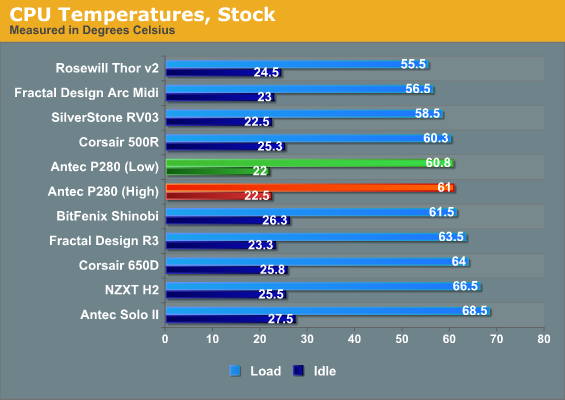
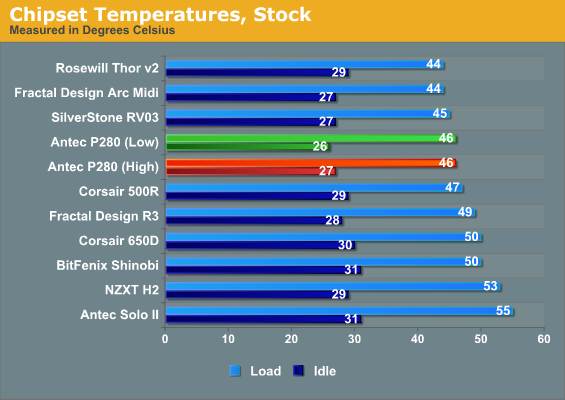
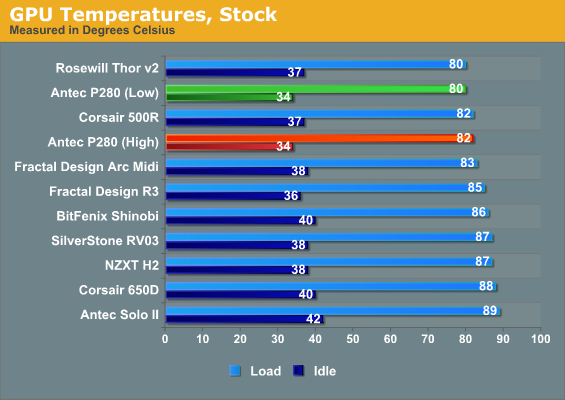
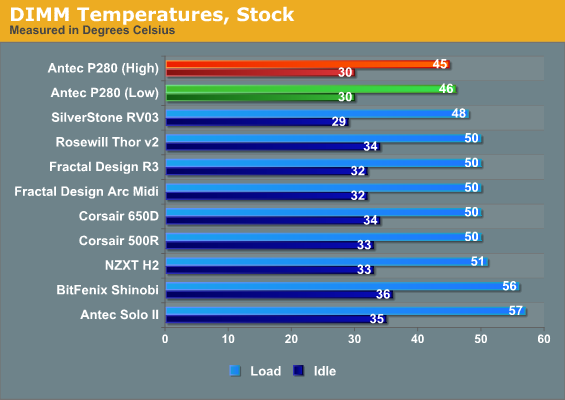

Performance for the P280 is for the most part middle-of-the-road. I think its biggest competitor is probably the up and coming Fractal Design Define R3. What's worth noting is the very minimal impact running the fans at low speeds seems to have had on the enclosure's performance.
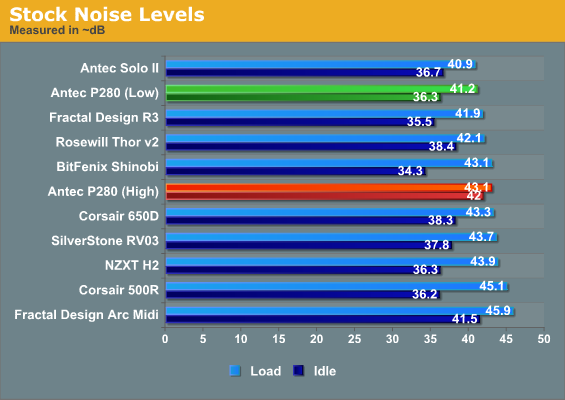
Turning down those fans results in one of the quietest cases we've tested under load, though the results are within the margin of error compared to Fractal Design's Define R3. When we let them ramp up, though, no amount of sound dampening can really save the P280. Thankfully running them at low barely affects thermals, and as a result we get decent performance from a quiet case. So far Antec is on the right track.










164 Comments
View All Comments
geniekid - Tuesday, November 15, 2011 - link
You're right. The temperature of the air around the CPU is probably the peak temp in the entire case.Because hot air rises and there are two fans on top, I think the CPU cooler is kind of fighting against the flow of air in its current configuration. I wonder if a CPU cooler blowing upwards would have an improvement in this scenario.
Strunf - Tuesday, November 15, 2011 - link
I don't think it would matter, natural convection doesn't have much to say when you have fans creating a flow of air, also if you turn the radiator by 90° then you'll be "aspirating" the air around the graphics card and that's counter productive.Folterknecht - Wednesday, November 16, 2011 - link
Take a Corsair H50 or something alike. Mount the the fans in the rear of the case (push/pull) and you ll get much better cpu temperatures - promised ;-)Folterknecht - Wednesday, November 16, 2011 - link
addition: The fans should blow/pull the cool from the outsidewelshy992 - Tuesday, November 15, 2011 - link
ANTEC TAKE MY MONEY!futurepastnow - Tuesday, November 15, 2011 - link
This may replace my old P150, which now has some noticeable chips in its paint, and is awfully cramped inside now that I have a real video card.Belard - Tuesday, November 15, 2011 - link
Hope you don't just give them money.... they have enough. Give it to me.And then I'll buy the case and send you photos.
Death666Angel - Tuesday, November 15, 2011 - link
I think I missed a trend. I have a Gigabyte P55M-UD4 and the CPU fan control is very adequate, silent in idle and good cooling under load when I want to. Are other mainboards from GB so bad concerning fan control? Because it's been mentioned in a few articles here and in comments.Other than that, good article and good case. Though too big for me. :-)
MrSpadge - Tuesday, November 15, 2011 - link
Don't know.. been using 5 different Gigabyte boards (home + work) during the last ~2 years. Fan control via PWM and SpeedFan has been fine, just not with their own utilities.MrS
ehume - Tuesday, November 15, 2011 - link
I quite agree. Read the manuals of Gigabyte boards and you learn that they control fans through both PWM and Voltage variation. There is one exception I saw (PWM only), but on all the rest, Gigabyte boards sure beat my PWM-only Asus board. Of course, you must enter BIOS to set this up, and if you haven't read your manual or thoroughly explored your BIOS you might miss it.